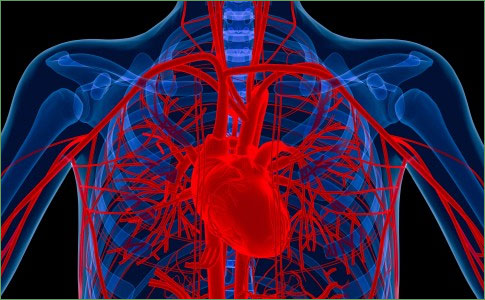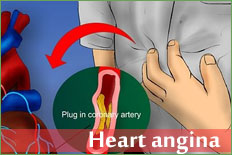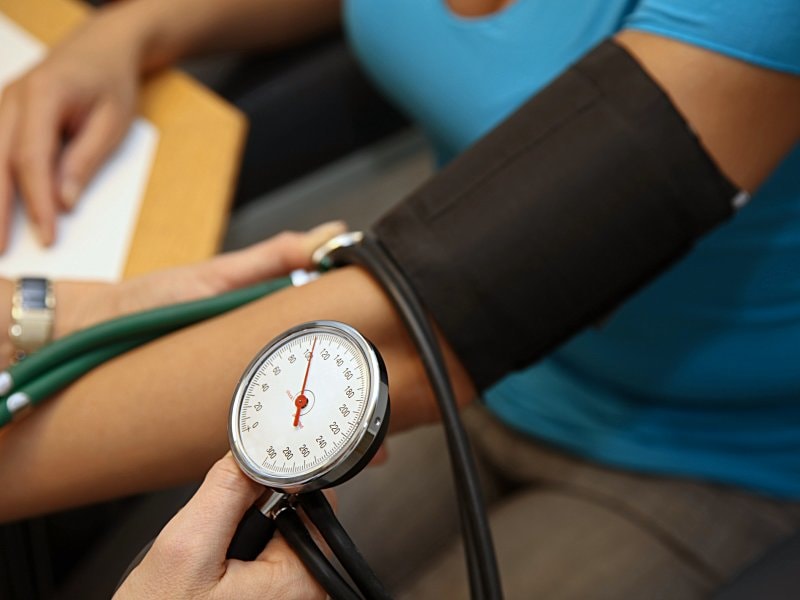Health Centers > Hypertension Health Center > Secondary Hypertension - Hypertension Etiology & Classification
Secondary Hypertension
B. SECONDARY HYPERTENSION
Approximately 5% of patients with hypertension have specific causes (Table 11-3). The history, examination, and routine laboratory tests may identify such patients. In particular, patients in whom hypertension develops at an early age, those who first exhibit hypertension when over age 50 years, or those previously well controlled who become refractory to treatment are more likely to have secondary hypertension. Causes include renal disease, genetic causes, renal vascular hypertension, primary hyperaldosteronism, Cushing's syndrome, pheochromocytoma, coarctation of the aorta (uncommon), hypertension associated with pregnancy, estrogen use, as well as other causes (eg, hypercalcemia and medications).
Hypertension Etiology & Classification
- Primary (Essential) Hypertension
L Sympathetic nervous system hyperactivity
L Abnormal cardiovascular development
L Renin-angiotensin system activity
L Defect in natriuresis
L Intracellular sodium and calcium
L Exacerbating factors - Secondary Hypertension
L Renal disease
L Genetic causes
L Renal vascular hypertension
L Primary hyperaldosteronism
L Cushing's syndrome
L Pheochromocytoma
L Coarctation of the aorta
L Hypertension associated with pregnancy
L Estrogen use
L Other causes of secondary hypertension
The ABCDE mnemonic can be used to help determine a secondary cause of hypertension: Accuracy of diagnosis, obstructive sleep Apnea, Aldosteronism, presence of renal artery Bruits (suggesting renal artery stenosis), renal parenchymal disease (Bad kidneys), excess Catecholamines, Coarctation of the aorta, Cushing's syndrome, Drugs, Diet, excess Erythropoietin, and Endocrine disorders. An algorithm showing the general strategy to help screen for factors involved in secondary hypertension is presented.
1. Renal disease - Renal parenchymal disease is the most common cause of secondary hypertension. Hypertension may result from diabetic and inflammatory glomerular diseases, tubular interstitial disease, and polycystic kidneys. Most cases are related to increased intravascular volume or increased activity of the renin-angiotensin-aldosterone system.
2. Genetic causes - Hypertension can be caused by mutations in single genes, inherited on a mendelian basis. Although rare, these conditions provide important insight into blood pressure regulation and possibly, the genetic basis of essential hypertension. Glucocorticoid remediable aldosteronism is an autosomal dominant cause of early-onset hypertension with normal or high aldosterone and low renin levels. It is caused by the formation of a chimeric gene encoding both the enzyme responsible for the synthesis of aldosterone (transcriptionally regulated by AII) and an enzyme responsible for synthesis of cortisol (transcriptionally regulated by ACTH).
As a consequence, aldosterone synthesis becomes driven by ACTH, which can be suppressed by exogenous cortisol. In the syndrome of apparent mineralocorticoid excess, early-onset hypertension with hypokalemic metabolic alkalosis is inherited on an autosomal recessive basis.
Although plasma renin is low and plasma aldosterone level is very low in these patients, aldosterone antagonists are effective in controlling hypertension. This disease is caused by loss of the enzyme 11β-hydroxysteroid dehydrogenase, which normally protects the otherwise promiscuous mineralocorticoid receptor in the distal nephron from inappropriate glucocorticoid activation, by metabolism of cortisol. Similarly, glycyrrhetinic acid, found in licorice, causes increased blood pressure through inhibition of 11β-hydroxysteroid dehydrogenase. The syndrome of hypertension exacerbated in pregnancy is inherited as an autosomal dominant trait. In these patients, a mutation in the mineralocorticoid receptor makes it abnormally responsive to progesterone and, paradoxically, to spironolactone. Liddle's syndrome is an autosomal dominant condition characterized by early-onset hypertension, hypokalemic alkalosis, low renin and low aldosterone levels. This is caused by a mutation that results in constitutive activation of the epithelial sodium channel of the distal nephron, with resultant unregulated sodium reabsorption and volume expansion.
3. Renal vascular hypertension - Renal artery stenosis is present in 1-2% of hypertensive patients. Its cause in most younger individuals is fibromuscular hyperplasia, particularly in women under 50 years of age. The remainder of renal vascular disease is due to atherosclerotic stenoses of the proximal renal arteries. The mechanism of hypertension is excessive renin release due to reduction in renal blood flow and perfusion pressure. Renal vascular hypertension may occur when a single branch of the renal artery is stenotic, but in as many as 25% of patients both arteries are obstructed.
Renal vascular hypertension should be suspected in the following circumstances: (1) if the documented onset is before age 20 or after age 50 years, (2) hypertension is resistant to three or more drugs, (3) if there are epigastric or renal artery bruits, (4) if there is atherosclerotic disease of the aorta or peripheral arteries (15-25% of patients with symptomatic lower limb atherosclerotic vascular disease have renal artery stenosis), (5) if there is abrupt deterioration in renal function after administration of ACE inhibitors, or (6) if episodes of pulmonary edema are associated with abrupt surges in blood pressure. There is no ideal screening test for renal vascular hypertension. If suspicion is sufficiently high, renal arteriography, the definitive diagnostic test, is the best approach.
Renal arteriography is not recommended as a routine adjunct to coronary studies. Where suspicion is moderate to low, radioisotope renography, duplex ultrasound, magnetic resonance angiography (MRA) or CT angiography have all been used successfully, but the results vary greatly among institutions. The extent of preexisting parenchymal damage to the affected and contralateral kidney has the greatest influence on blood pressure and renal function outcomes following revascularization. Correction of the lesion should be considered in young individuals and in low-risk patients of any age with blood pressure that is resistant to medical therapy. Percutaneous intervention with stent placement is the preferred approach for fibromuscular hyperplasia and for discrete stenotic arteriosclerotic lesions that do not involve the renal artery ostium. In older individuals with arteriosclerosis, only a minority experience complete normalization without continued drug therapy. Thus, it is reasonable to manage these patients medically if renal function does not deteriorate. Although ACE inhibitors have improved the success rate of medical therapy of hypertension due to renal artery stenosis, they have been associated with marked hypotension and (usually reversible) renal dysfunction in individuals with bilateral renal artery stenosis. Thus, renal function and blood pressure should be closely monitored during the first weeks of therapy in patients in whom this is a consideration.
4. Primary hyperaldosteronism - Primary hyperaldosteronism occurs because of excessive secretion of aldosterone by the adrenal cortex. It may, in fact, be the most common potentially curable and specifically treatable cause of hypertension. In the past, the diagnosis was often suspected when hypokalemia prior to diuretic therapy associated with excessive urinary potassium excretion (usually > 40 mEq/L on a spot specimen) and suppressed levels of plasma renin activity presented in hypertensive patients. However, the development and application of new screening tests to the population of hypertensive persons have resulted in a marked increase in the detection rate for primary hyperaldosteronism. It now appears that up to 5-15% of patients in whom primary (essential) hypertension is diagnosed actually have primary hyperaldosteronism, with most having normal serum potassium levels. Currently, the best screening test for primary hyperaldosteronism involves determinations of plasma aldosterone concentration (normal: 1-16 ng/dL) and plasma renin activity (normal: 1-2.5 ng/mL/h) and calculation of the plasma aldosterone/renin ratio (normal: < 25). Medications that alter renin and aldosterone levels, including ACE inhibitors, angiotensin receptor blockers (ARBs), and diuretics (especially spironolactone), should be discontinued at least a week before sampling. Patients with aldosterone/renin ratios of ≥ 25 require further evaluation for primary hyperaldosteronism. The lesion responsible is an adrenal adenoma, though some patients have bilateral adrenal hyperplasia. The lesion can be demonstrated by CT or MRI scanning.
5. Cushing's syndrome - Less commonly, hypertension presents in patients with Cushing's syndrome (glucocorticoid excess). However, among those with spontaneous Cushing's syndrome, hypertension occurs in about 75-85% of patients. The exact pathogenesis of the hypertension is unclear. It may be related to salt and water retention from the mineralocorticoid effects of the excess glucocorticoid. Alternatively, it may be due to increased secretion of angiotensinogen. While plasma renin activity and concentrations are generally normal or suppressed in Cushing's syndrome, angiotensinogen levels are elevated to approximately twice normal because of a direct effect of glucocorticoids on its hepatic synthesis, and angiotensin II levels are increased by about 40%. Administration of the angiotensin II antagonist saralasin to patients with Cushing's syndrome causes a prompt 8- to 10-mm Hg drop in systolic and diastolic blood pressure. In addition, glucocorticoids exert permissive effects on vascular tone by a variety of mechanisms.
6. Pheochromocytoma - Pheochromocytomas are uncommon; they are probably found in less than 0.1% of all patients with hypertension and in approximately two individuals per million population. In about 50% of patients with pheochromocytoma, hypertension is sustained but the blood pressure shows marked fluctuations, with peak pressures during symptomatic paroxysms. During a hypertensive episode, the systolic blood pressure can rise to as high as 300 mm Hg. In about one-third of cases, hypertension is truly intermittent. In some cases, hypertension is absent. The blood pressure elevation caused by the catecholamine excess results from two mechanisms: α-receptor-mediated vasoconstriction of arterioles, leading to an increase in peripheral resistance, and β1-receptor-mediated increases in cardiac output and in renin release, leading to increased circulating levels of angiotensin II. The increased total peripheral vascular resistance is probably primarily responsible for the maintenance of high arterial pressures. Chronic vasoconstriction of the arterial and venous beds leads to a reduction in plasma volume and predisposes to postural hypotension.
Indeed, the majority of patients have orthostatic decreases in blood pressure, the converse of primary (essential) hypertension. Glucose intolerance develops in some patients. Hypertensive crisis in pheochromocytoma may be precipitated by a variety of drugs, including tricyclic antidepressants, antidopaminergic agents, metoclopramide, and naloxone.
7. Coarctation of the aorta - This uncommon cause of hypertension.
8. Hypertension associated with pregnancy - Hypertension occurring de novo or worsening during pregnancy, including preeclampsia and eclampsia, is one of the most common causes of maternal and fetal morbidity and mortality.
9. Estrogen use - A small increase in blood pressure occurs in most women taking oral contraceptives, but considerable increases are noted occasionally. This is caused by volume expansion due to increased activity of the renin-angiotensin-aldosterone system. The primary abnormality is an increase in the hepatic synthesis of renin substrate. Five percent of women taking oral contraceptives chronically exhibit a rise in blood pressure above 140/90 mm Hg, twice the expected prevalence. Contraceptive-related hypertension is more common in women over 35 years of age, in those who have taken contraceptives for more than 5 years, and in obese individuals. It is less common in those taking low-dose estrogen tablets. In most, hypertension is reversible by discontinuing the contraceptive, but it may take several weeks. Postmenopausal estrogen does not generally cause hypertension, but rather maintains endothelium-mediated vasodilation.
10. Other causes of secondary hypertension - Hypertension has also been associated with hypercalcemia due to any cause: acromegaly, hyperthyroidism, hypothyroidism, and a variety of neurologic disorders causing increased intracranial pressure. A number of other medications may cause or exacerbate hypertension - most importantly cyclosporine and NSAIDs.
Bibliography
August P: Overview: mechanisms of hypertension: cells, hormones, and the kidney. J Am Soc Nephrol 2004;15:1971. [PMID: 15284282]
Bravo EL: Pheochromocytoma. Cardiol Rev 2002;10:44. [PMID: 11790269]
Failor RA et al: Hyperaldosteronism and pheochromocytoma: new tricks and tests. Prim Care 2003;30:801. [PMID: 15024897]
Freel EM et al: Mechanisms of hypertension: the expanding role of aldosterone. J Am Soc Nephrol 2004;15:1993. [PMID: 15284285]
Hartman RP et al: Evaluation of renal causes of hypertension. Radiol Clin North Am 2003;41:909. [PMID: 14521201]
Lifton RP et al: Molecular mechanisms of human hypertension. Cell 2001;104:545. [PMID: 11239411]
Loney EL et al: Renovascular hypertension. Q J Nucl Med 2002; 46:283. [PMID: 12411868]
Nordmann AJ et al: Balloon angioplasty versus medical therapy for hypertensive patients with renal artery obstruction. Cochrane Database Syst Rev 2003;(3):CD002944. [PMID: 12917937]
Nussberger J: Investigating mineralocorticoid hypertension. J Hypertens Suppl 2003;21(Suppl 2):S25. [PMID: 12929904]
Onusko E: Diagnosing secondary hypertension. Am Fam Physician 2003;67:67. [PMID: 12537168]
Oparil S et al: Pathogenesis of hypertension. Ann Intern Med 2003;139:761. [PMID: 14597461]
Radermacher J et al: Techniques for predicting a favourable response to renal angioplasty in patients with renovascular disease. Curr Opin Nephrol Hypertens 2001;10:799. [PMID: 11706308]
Reaven G: Insulin resistance, hypertension, and coronary heart disease. J Clin Hypertens 2003;5:269. [PMID: 12939567]
Safar ME et al: Vascular development, pulse pressure, and the mechanisms of hypertension. Hypertension 2005;46:205. [PMID: 15911744]
Stas SN et al: Pathogenesis of hypertension in diabetes. Rev Endocr Metab Disord 2004;5:221. [PMID: 15211093]
Strazzullo P et al: Altered renal handling of sodium in human hypertension: short review of the evidence. Hypertension 2003;41:1000. [PMID: 12668589]
Textor SC: Managing renal arterial disease and hypertension. Curr Opin Cardiol 2003;18:260. [PMID: 12858123]
Young WF Jr: Minireview: primary aldosteronism - changing concepts in diagnosis and treatment. Endocrinology 2003;144: 2208. [PMID: 12746276]


